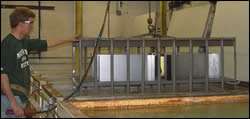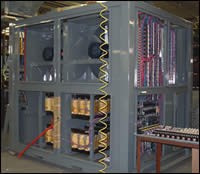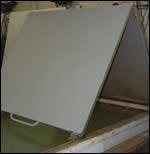Do It Yourself
Simplex, Inc., a manufacturer of electrical test systems and fuel supply systems, established a need to upgrade its pretreatment line from a three-stage system to a five-stage system. Equipped with experience in fluid transportation and storage, they decided to design and build it themselves...
These days, thanks in large part to the easy dissemination of information made possible by the Internet, the "do-it-yourself" mentality has permeated virtually every recess of our collective consciousness, from home remodeling to web site design. There's even an entire television network (the aptly named Do It Yourself Network) devoted to enthusiasts of the self-sufficient approach to life.
It comes as no surprise then, that the do-it-yourself approach should find a place in the industrial finishing industry. That's been the case at Simplex, Inc. (Springfield, IL), a 47-year old manufacturer of specialized electrical test systems and fuel supply systems.
Featured Content
Simplex's customers include Caterpillar, General Electric, Sundstrand, Boeing and all branches of the military. Many hospitals throughout the country rely on Simplex products to test emergency backup electrical power, and Simplex equipment is used to test the McDonnell-Douglas MD-11 and MD-80, Boeing 777 jetliners, the Space Shuttle, Navy destroyers and cruisers and nuclear submarines. Nearly all of the company's products are fabricated from steel and aluminum.
Durability and corrosion resistance are of particular concern to Simplex. Not only are its products shipped all over the world—where they are exposed to a variety of climatic conditions—but many of them must be UL approved. That approval is awarded partially on the basis of the quality of the finish. Panels are regularly shipped to underwriters laboratories, where they undergo a battery of tests (e.g. salt spray) designed to assess corrosion protection.
A Dirty Dilemma
Three years ago, Simplex opted to take a more environmentally-friendly approach to its paint shop operations. In doing so, it made the conversion from solvent-based paint to waterborne paint (today, approximately 85% of the company's parts are coated with waterborne coatings). While the change allowed Simplex to meet its environmental requirements, the waterborne paint proved much less forgiving when it came to parts that were not thoroughly cleaned and pretreated.
That meant revisiting the pretreatment system. At the time, Simplex was using a three-stage immersion tank system composed of a combination cleaner/DuBois Chemicals, Surface Finishing, the company determined that the combined cleaner/phosphatizer was not effectively removing the heavy soils from the parts, compromising every subsequent step of the pretreatment and paint processes. "We needed the part surfaces to be exceptionally clean for the sake of the UL approvals," says Dean Barnard, production and facilities manager at Simplex. "The three-stage system we were using just wasn't allowing for enough cleaning to take place."
Complicating matters is the fact that the pretreatment system is housed in the same facility as the welding and grinding operations (Simplex works from several small interlinked buildings as opposed to a single, large plant)—not exactly the most pretreatment-friendly environment in the world. And since the paint line is in the building next door, parts had to be palletized and then transported to the paint line, widening the window of opportunity for flash rust to occur.
Don Foutch, a sales representative with DuBois Chemicals, Surface Finishing, suggested to Barnard that the pretreatment system should be expanded to a five-stage system, with separate tanks devoted to the alkaline wash and phosphatizing processes. Doing so would allow for a more aggressive cleaner stage and would also allow for a second rinse stage to be included in the pretreatment. Foutch also recommended upgrading the seal stage to a more rust-prohibitive chemistry.
Getting Started
Once the decision was made to develop a new pretreatment system, Barnard and his colleagues began speculating that maybe —perhaps given their company's experience with the design and fabrication of fluid storage and movement equipment—it was something they could build on their own. They sought, and received, approval from company management to develop the system as a "do-it-yourself" project.
Barnard put together a team composed of Simplex employees to design and build the new system. The group—which included Garland Stevens, manager of mechanical engineering; Rick Pile, manager of fuel supply systems; Jon Thaxton, supervisor of drafting; Mike Nichols, supervisor of maintenance and Steve Schnelten, supervisor of weld and paint—met once a week for six months, during which time they brainstormed. "We looked at everything," says Barnard. "Plumbing, drainage, electrical requirements—you name it, we covered it." Though decisions were generally made by the group as a whole, each member of the building team was assigned to specific areas of the new system to focus on.
One of the biggest questions the design team had to answer had to do with space or the lack thereof. "We really didn't have much room to expand," says Barnard. "At the same time, we knew we needed to go from three tanks to five, while still keeping the tanks large enough to handle some of our bigger parts." Consequently, the group adopted a design in which much of the plumbing, motors and valves would be discretely hidden—but still easily accessible—below the deck that runs along the front of the system.
Though construction was a relatively painless process, Barnard concedes that the building team had another six months of "debugging" before the system was operating at satisfactory levels. "We've learned a tremendous amount since we first flipped the switch," he says with a laugh.
One such learning experience came in nailing down the appropriate degree of aggressiveness for the new cleaner. "We went from a cleaner that wasn't strong enough to remove the soil from the substrates to one that was actually eating away at some of the seals in the system," says Barnard. Another issue revolved around finding a cleaner that would do a satisfactory job on both aluminum and steel.
A Custom Fit
One of the benefits of building your own pretreatment system is the ability to tailor it to "hug every curve" of your facility. That's precisely what the Simplex team did.
One such customization was the inclusion of automatic covers to prevent heat loss at night and protect the system against any particulate generated as a result of the welding and grinding operations. "Moving the system away from the welding area wasn't an option at the time," says Barnard. "So we wanted to have some kind of defense mechanism against the garbage in the air."
For better cleaning, a circulation pump was introduced to provide agitation to the alkaline soak tank—a direct result of Barnard's conversations with DuBois. "We explained to [Simplex] the role that agitation could play in removing some of those tough soils from the steel," says Foutch. "The addition of circulation to the tank has made a significant impact on part cleanliness."
Simplex also integrated a number of controls into the system, giving the pretreatment technicians the ability to regulate a number of factors including operating temperature, pH, tank levels, agitation and chemical dispensation. In order to conserve power, the system relies on an adjustable on/off timer, which allows the tank temperatures to be set at lower settings during off hours.
Barnard and his team have already started thinking about developing "version 2.0" of the pretreatment system. "We've recently been presented with the opportunity to move the pretreatment into the same building as the paint line," he says. "Obviously, this opens the door for a continuous paint line, with the cleaning and pretreatment integrated into it." Barnard says that the next version of the line will likely include holding tanks (to make draining and cleaning more efficient) and an even greater degree of controls and automation.
| FIGURE 1. Dip Line System Specifications: | |||||
| Stage #1 |
Stage #2 | Stage #3 |
Stage #4 | Stage #5 |
|
|
Description |
Alk Wash 5.0-7.0% 170-180°F 13-14 5 min |
Rinse |
Phosphatize 4-6.0% 130-150°F 4.0-4.5 5 min |
Rinse 100-120°F 5-7 3 min |
Sealer 0.4-0.8% 100-120°F 9-9 3 min |
Also on Barnard's agenda is the possibility of expanding Simplex's business offerings by going into the production of pretreatment systems on a commercial basis. "We feel that we know enough right now that we could effectively design a system for another finisher, spec it out and fabricate it," he says. "It's a logical addition to our offerings as a company."
In a "do not try this at home" tone, Barnard warns that the do-it-yourself approach is not for everyone. "In our case, we happened to have the expertise and tools available to make this happen," he says. "Our fuel supply system business is all about storing fluids and moving fluids around. We knew that we could take that experience, couple it with the assistance and expertise of our suppliers and come away with something we'd be proud to use on a day-to-day basis."






















